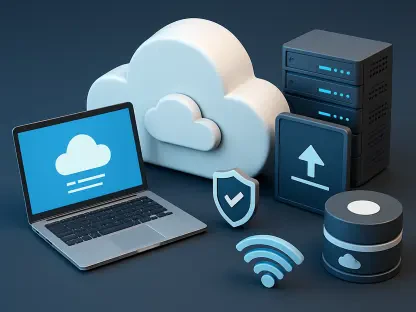In a world where midnight transactions on global online retail platforms can encounter unexpected spikes and subsequent failures, the race to diagnose problems with traditional monitoring tools often turns into a wild goose chase. This scenario is becoming increasingly common as modern cloud architectures grow more complex, leaving operations teams struggling to identify root causes. Enter the era of cloud-native observability. By 2025, the observability landscape is expected to undergo a profound transformation driven by the integration of AI open-source frameworks and security-focused strategies, providing deeper insights into system behavior. This article will explore the essential trends that will shape the future of observability.
AI-Enabled Observability
The shift from reactive to proactive monitoring is one of the most significant advancements in observability. AI and machine learning integrations have revolutionized observability platforms, enabling predictive monitoring. AI-enabled solutions analyze historical data, recognize patterns, and forecast potential problems before they disrupt services. For instance, AI-driven anomaly detection can identify subtle variations in microservices response times, alerting engineers ahead of service outages. Companies like New Relic and Dynatrace have already made significant strides in AI-driven insights, and by 2025, we can anticipate remarkable advancements in automation for root cause analysis, self-healing systems, and dynamic observability dashboards.
This progress brings several key benefits to the table. Firstly, AI reduces the mean time to detection (MTTD) and mean time to recovery (MTTR) by streamlining the root cause analysis process. Faster incident resolution minimizes service downtime, enhancing user experience and operational efficiency. Secondly, predictive analytics enable engineering teams to optimize applications proactively, improving performance and preventing issues. Lastly, AI helps mitigate alert fatigue by differentiating critical alerts from non-essential ones, allowing teams to focus on urgent matters.
OpenTelemetry and Open Source Observability Standards
Vendor lock-in has long plagued the observability sector, but the advent of OpenTelemetry (OTel) and open-source observability standards is set to disrupt the industry. As a leading standard for collecting distributed traces, metrics, and logs, OpenTelemetry has gained widespread adoption among cloud service providers and enterprises. By 2025, the OpenTelemetry ecosystem is expected to expand further, offering enhanced integrations, improved trace visualization capabilities, and better support for event-driven architectures. Organizations are likely to shift from proprietary agents to OTel, leveraging its flexibility in instrumenting applications across hybrid and multicloud environments.
The significance of OpenTelemetry lies in its ability to standardize telemetry data collection across diverse environments. This standardization fosters interoperability, allowing seamless integration with cloud-native observability tools like Prometheus, Grafana, and Jaeger. Additionally, OpenTelemetry reduces operational costs by eliminating the need for multiple proprietary agents. To get started with OpenTelemetry, follow this step-by-step guide for implementing distributed tracing in a Kubernetes environment:
Deploy the OpenTelemetry Collector:
- Create a Kubernetes namespace specifically for observability:
kubectl create namespace observability - Deploy the OpenTelemetry Collector using Helm:
helm repo add open-telemetry https://open-telemetry.github.io/opentelemetry-helm-chartshelm repo updatehelm install otel-collector open-telemetry/opentelemetry-collector -n observability
- Create a Kubernetes namespace specifically for observability:
Instrument Your Application:
- Incorporate OpenTelemetry SDKs into your application (example in Python):
pip install opentelemetry-sdk opentelemetry-exporter-otlp - Configure the application to relay traces to the OpenTelemetry Collector:
from opentelemetry.sdk.trace import TracerProviderfrom opentelemetry.sdk.trace.export import BatchSpanProcessorfrom opentelemetry.exporter.otlp.proto.grpc.trace_exporter import OTLPSpanExportertracer_provider = TracerProvider()processor = BatchSpanProcessor(OTLPSpanExporter(endpoint="https://otel-collector:4317"))tracer_provider.add_span_processor(processor)
- Incorporate OpenTelemetry SDKs into your application (example in Python):
Visualize Traces in Jaeger:
- Deploy Jaeger for trace visualization:
kubectl apply -f https://raw.githubusercontent.com/jaegertracing/jaeger-kubernetes/master/all-in-one/jaeger-all-in-one-template.yml - Access the Jaeger UI:
Open Jaeger UI in your browser to view traces.kubectl port-forward svc/jaeger-query 16686:16686 -n observability
- Deploy Jaeger for trace visualization:
By following these steps, you can gain real-time insights into microservices interactions, detecting performance bottlenecks more effectively.
DevSecOps: The Convergence of Security and Observability
Security is evolving from a siloed function to a core element of observability. As organizations adopt DevSecOps workflows, the emphasis on security monitoring shifts left, enabling earlier detection of vulnerabilities in the software development lifecycle. Modern observability tools are now equipped with real-time threat detection capabilities, scrutinizing application logs for unusual patterns indicative of security breaches. By 2025, security observability will encompass several critical aspects:
- SBOM (Software Bill of Materials) monitoring will identify vulnerabilities in software dependencies.
- Runtime security observability will detect and mitigate threats as they occur.
- Compliance automation will ensure that cloud environments adhere to regulatory standards such as GDPR and HIPAA.
The integration of security and observability empowers organizations to maintain robust defenses against evolving threats, safeguarding sensitive data and ensuring regulatory compliance.
The Influence of FinOps on Observability Expenditures
Observability can be expensive, especially with the growing volume of telemetry data. As organizations scale their data collection efforts, cloud costs can quickly spiral out of control. This is where FinOps (Cloud Financial Management) becomes crucial. By 2025, many companies will adopt cost-conscious observability practices, striking a balance between visibility and financial constraints. FinOps-informed observability strategies will include smart data retention, dynamic sampling rates, and cloud-based cost analytics.
Smart data retention involves preserving high-value telemetry data while discarding superfluous logs, reducing storage costs without compromising visibility. Dynamic sampling rates adjust trace sampling based on system workload, ensuring optimal data collection without overwhelming the infrastructure. Cloud-based cost analytics provide insights into observability expenditures, enabling organizations to manage costs effectively and allocate resources efficiently.
Final Reflections: The Evolution of Observability
In a world where late-night transactions on international online retail platforms can face unexpected surges and subsequent failures, the race to diagnose issues using traditional monitoring tools often becomes a futile pursuit. As modern cloud architectures become increasingly intricate, operations teams frequently struggle to pinpoint root causes of problems. This growing complexity highlights the need for a new approach: cloud-native observability. By 2025, this observability landscape is set for a significant evolution. The integration of AI open-source frameworks and security-focused strategies will drive this transformation, offering deeper insights into system behaviors. This article will delve into the crucial trends poised to shape the future of observability, ensuring systems remain robust and reliable amid growing challenges. Advances in technology and a focus on enhanced security will redefine how we understand and manage cloud environments, paving the way for more effective, proactive approaches.









